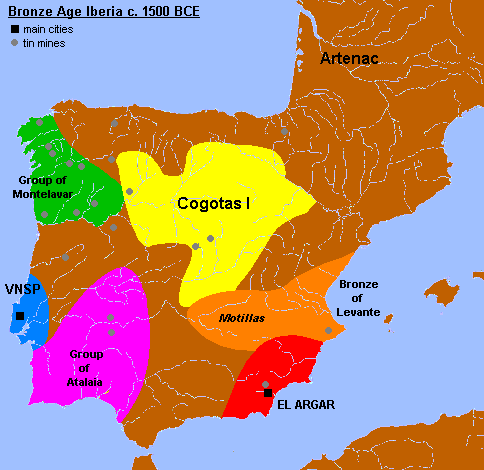 |
| Motilla del Azuer |
This bone, placed around the base of the tongue, is often broken in case of strangulation (including hangings) but otherwise a rare lesion. However the very fact that the man survived suggests to researchers that in this case the lesion was caused by a direct impact.
Full story at Unreported Heritage News (paper to be published at Journal of Osteoarchaeology). More information on the archaeological work at Motilla del Azuer at Science Daily (2007).
Las Motillas in context
The Motillas are fortifications, rather similar to the more famous Sardinian Nuraghe, erected at La Mancha in the Middle Bronze Age and abandoned a few centuries later. Culturally they are more akin to the Bronze of Levante (Valencian Country) but are surely also related to the regional power of the age: El Argar civilization (Almería, Murcia). This group of cultures is surely at the roots of historical Iberians.
El Argar and its hinterland was the core of the Iberian Bronze Age, beginning c. 1800 BCE. They are probably the ancestors of historical Iberians and were at a later stage (since c. 1500 BCE) influenced to some extent by Mycenaean Greece. It was in this B phase of the Middle Bronze Age, when the inland fortifications known as Las Motillas in Spanish (exactly the same concept as motte-and-bailey in English) were erected to live for about two or three centuries.
 |
| Las Motillas in the context of Middle Bronze Age Iberia |
I believe that their construction in this otherwise uninteresting steppe (showing little signs of habitation before and after them) was triggered by the need of El Argar (surely a centralized state) of securing a safe inland route towards NW Iberia, which was like the Persian Gulf of the Bronze Age because of its huge reserves of tin, an otherwise rare metal necessary for the forge of bronze. The rest of the route would go (possibly) through the lands of the cattle-herder peoples of Cogotas I culture in the Iberian Plateau.
An alternative route was through the sea but there it had to go by the coasts of another (maybe rival) power: Zambujal (Vila Nova de São Pedro culture). Some of the produce would surely remain in Iberia (El Argar and allies) but much, I understand, would be exported to Greece, where it would have fed their militaristic tendencies maybe (culminating in the destruction of Troy and much of the Sea Peoples' episode). No Greek outpost is known to have existed anywhere in Iberia but Greek burial styles were adopted by the Argarians since c. 1500 BCE, strongly suggesting they were trade partners. Otherwise only a few glass beads of Oriental origin attest the trade which must have been mostly about raw products such as tin, copper, gold and silver.
No comments:
Post a Comment
Please, be reasonably respectful when making comments. I do not tolerate in particular sexism, racism nor homophobia. Personal attacks, manipulation and trolling are also very much unwelcome here.The author reserves the right to delete any abusive comment.
Preliminary comment moderation is... ON (your comment may take some time, maybe days or weeks to appear).